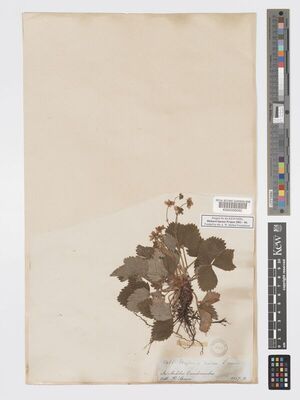Geography and distribution
Woodland strawberry is native from the west of the Ural Mountains throughout northern Europe and across North America.
It has the largest native range of the strawberries.
Description
Overview: Perennial herb up to about 30 cm tall, producing many long, spreading, above-ground stolons (runners).
Leaves: In a basal rosette, glossy bright green, divided into three leaflets. Leaflets up to 6 cm long with a toothed margin, sparsely hairy on upper surface, with a fine greyish covering of hair beneath.
Flowers: Up to 18 mm in diameter, usually bisexual, with five rounded white petals up to 5 mm long. Sepals (usually 10) up to 4 mm long. Scape (flower stalk) up to 30 cm long, each bearing 2-7 flowers.
Fruit: 'Fruit' up to 1 cm long and composed of many small, hairless achenes (dry, thin-walled fruits) scattered on the surface of an enlarged, conical, fleshy red receptacle.
Some important cultivars:
'Alexandria' - fruit small, red, sweet'Alpine Yellow' - fruit small, yellow, sweet'Baron Solemacher' - fruit small, red, acid to sweet'Rügen' - fruit large, red, aromatic, productive'Semperflorens' - alpine strawberry/
fraise du bois - to 25 cm, almost without runners, flowers and fruits small, flowers early summer and again in autumn'Variegata' - leaves variegated cream and grey-green What is a fruit?
The juicy, edible part of a strawberry plant that is generally known as the fruit is in fact a swollen receptacle, on the surface of which the true fruits (resembling red or yellow pips) are embedded.
Uses
The fragrant, juicy fruits of woodland strawberry have long been picked and eaten in the wild and provide a tasty treat for travellers today.
Potentilla vesca was probably cultivated by the ancient Romans and Greeks and was grown across Europe by the 1300s. The plants produce rooted runners bearing small clusters of leaves, which can easily be removed from the parent plant and transported elsewhere for cultivation.
A 16th century recipe for strawberry shortcake includes woodland strawberry and almond flour in its ingredients.
Woodland strawberry is rarely cultivated on a commercial scale due to the small size of the fruits and low yield, but the fruits are perceived by many to have a superior flavour and are used in patisserie, particularly in France and central Europe. The cultivar Potentilla vesca 'Semperflorens', known as alpine strawberry, is a favourite for use in for European pastries.
With its glossy green leaves and pretty white flowers, woodland strawberry can be planted as a semi-ornamental in herb and vegetable gardens. Potentilla vesca 'Alexandria' and P. vesca 'Alpine Yellow' are attractive cultivars for this purpose.
Commercial strawberry production
The main hybrid used in commercial strawberry production is Potentilla × ananassa . It was produced by crossing two American species, P. virginiana (a woodland species from eastern USA) and P. chiloensis (west coast pine strawberry, from the western coast of North and South America).
Strawberries are an economically important crop, produced in significant quantities in more than 75 countries, with an annual production of more than 4000 megatonnes.
They are used in desserts, jams, jellies, ice-cream, syrups, juices and bakery products (including strawberry shortcake) and are also sold fresh, canned, frozen, dried and freeze-dried. Fresh strawberries are traditionally eaten with cream in the UK or sour cream elsewhere in Europe.
Millennium Seed Bank: Seed storage
The Millennium Seed Bank Partnership aims to save plant life worldwide, focusing on plants under threat and those of most use in the future. Seeds are dried, packaged and stored at a sub-zero temperature in our seed bank vault.
Fourteen collections of Potentilla vesca seeds are held in Kew's Millennium Seed Bank based at Wakehurst in West Sussex.
This species at Kew
Potentilla vesca can be seen growing in the Queen's Garden (behind Kew Palace) and the Conservation Area at Kew.
Dried and spirit-preserved specimens of Potentilla vesca are held in Kew's Herbarium where they are available to researchers by appointment.
Specimens of seeds of Potentilla vesca are held in Kew's Economic Botany Collection, where they are available to researchers by appointment.

























